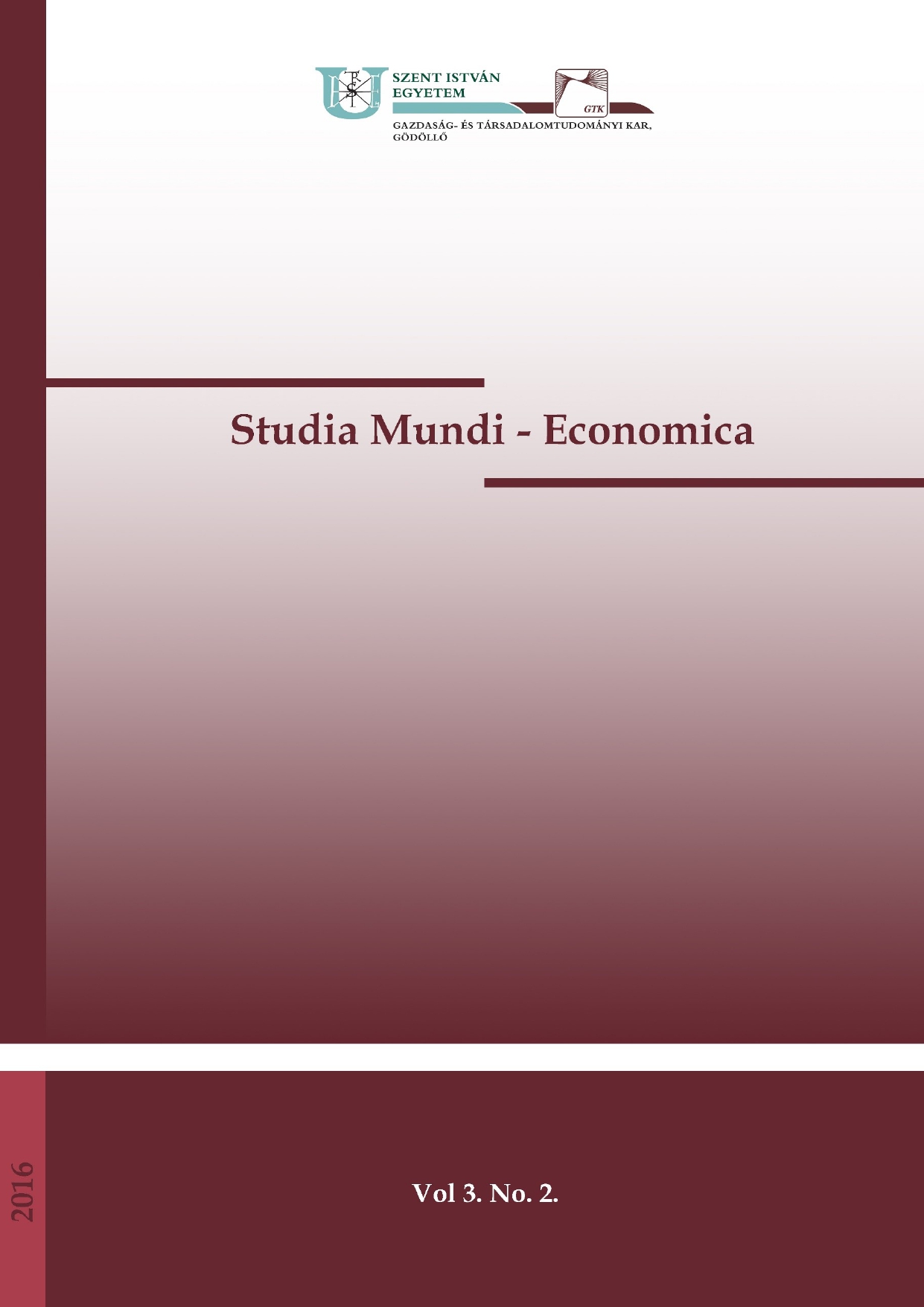The examination of ecosystem valuation using revealed preference approach
DOI:
https://doi.org/10.18531/Studia.Mundi.2016.03.02.59-67Keywords:
környezetértékelés, kinyilvánított preferencia, természeti erőforrások, vízgazdálkodásAbstract
According to the current European and global trends the consideration of environmental values in decision making processes is turning to be a more and more significant aspect in political level. The number of the ecosystem valuation cases is highly increasing and the application surface for the certain methodologies includes local, national and global level examinations as well. Our research aims to discover a broader horizon of social and economic values of a project which targeted environmental improvement in the first place. The present paper introduces a case study for the economic valuation of natural capital through revealed preference methodology. The subject of the examination is an actual project concerning the revitalization of the Szabadság Island side branch of the Danube near Mohács.
References
Boros T. (2004): Két új ökológiai fogalom: a „természeti tőke” és a „környezeti fenntarthatóság” értelmezése és alkalmazása gyakorlati problémákra. Műszaki információ. Környezetvédelem. Vol. 9-10. 3-23. p. ISSN 0209-5769.
Brand F. (2009): Critical natural capital revisited: ecological resilience and sustainable development. Ecological Economics Vol. 68. No. 3. 605-612. p. DOI: http://dx.doi.org/10.1016/j.ecolecon 2008.09.013
Brouwer R. (2006): Do stated preference methods stand the test of time? A test of the stability of contingent values and models for health risks when facing an extreme event. Ecological Economics. Vol. 60. No. 2. 399-406. p. DOI: http://dx.doi.org/10.1016/j.ecolecon.2006.04.001
Costanza R. – Daly H. E. (1992): Natural capital and sustainable development. Conservation Biology. Vol. 6. 37–46. p. DOI: http://dx.doi.org/10.1046/j.1523- 1739.1992.610037.x
Clucas B. – Rabotyagov S. – Marzluff J. M. (2015): How much is that birdie in my backyard? A cross-continental economic valuation of native urban songbirds. Urban Ecosyst. Vol. 18. No. 1. 251–266. p. DOI: http://dx.doi.org/10.1007/s11252-014-0392-x
Fogarassy, Cs, Kovacs, A. (2016): The cost-benefit relations of the future environmental related development strategies in the Hungarian energy sector. YBL Journal Of Built Environment. Vol. 4. No. 1. 33-48. p. DOI: http://dx.doi.org/10.1515/jbe-2016-0004
Fogarassy, Cs., Lukács, Á., Nagy, H. (2008): Potential benefits of linking the Green Investment Scheme of the Kyoto Protocol with institutional voluntary markets like the Chicago Climate Exchange. In: ENVECON - UK Network of Environmental Economics. London, Nagy-Britannia. 14. p.
Hacsaturov T. Sz. (1985): A természethasznosítás gazdaságtana. Budapest, Közgazdasági és Jogi Könyvkiadó, 295. p., ISBN: 9632215397
Kontoleon A. – Pascual U. 2007. Incorporating Biodiversity into Integrated Assessments of Trade Policy in the Agricultural Sector. Volume II: Reference Manual. Chapter 7. Economics and Trade Branch, Geneva, United Nations Environment Programme.
KSH 2013: Népszámlálás 2011. Részletes táblák http://www.ksh.hu/nepszamlalas/reszletes_tablak (letöltve: 2014.11.22)
Marjainé Szerényi Zs. (szerk.) (2005a): A természetvédelemben alkalmazható közgazdasági értékelési módszerek. Budapest, Környezetvédelmi és Vízügyi Minisztérium, 155. p., ISBN 963218307x
Marjainé Szerényi Zs. (2005b): A feltételes értékelés alkalmazhatósága Magyarországon. Budapest, Akadémiai Kiadó, 192 p., ISBN: 9789630582353
Pearce D. – Moran D. (1994): The Economic Value of Biodiversity. London, IUCN, Earthscan Publications Ltd., 172 p., ISBN: 185383195614. Szlávik, J. (2005): Fenntartható környezet- és erőforrásgazdálkodás. Budapest, KJKKerszöv Jogi és Üzleti Kiadó Kft., 317 p.
TEEB Foundations (2010): The Economics of Ecosystems and Biodiversity Ecological and Economic Foundations. Edited by Pushpam Kumar. London and Washington, Earthscan. 456 p., ISBN: 9780415501088
Ungvári G. – Molnár Zs. – Varga Gy. – Ellison D. (2012): Ökoszisztéma- szolgáltatások nagyságrendi becslése vízgyűjtő szinten a vízkörforgást leíró vízháztartási jellemzők alapján. Budapest, 31 p.
Vatn A. – Bromley D. V. (1994): Choices without Prices without Apologies. Journal of Environmental Economics and Management. Vol. 26. No. 2. 129–148. p. DOI: http://dx.doi.org/10.1006/jeem.1994.1008
Downloads
Published
Issue
Section
License
Copyright (c) 2016 Kerpely Klára, Horváth Bálint, Bakosné Böröcz Mária

This work is licensed under a Creative Commons Attribution-NonCommercial-NoDerivatives 4.0 International License.
A folyóirat Open Access (Gold). Cikkeire a Creative Commons 4.0 standard licenc alábbi típusa vonatkozik: CC-BY-NC-ND-4.0. Ennek értelmében a mű szabadon másolható, terjeszthető, bemutatható és előadható, azonban nem használható fel kereskedelmi célokra (NC), továbbá nem módosítható és nem készíthető belőle átdolgozás, származékos mű (ND). A licenc alapján a szerző vagy a jogosult által meghatározott módon fel kell tüntetni a szerző nevét és a szerzői mű címét (BY).






